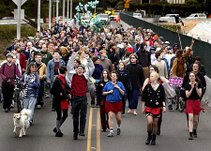[olympiaworkers] March 4: Strikes and Occupations in California and across the US
Libcom.org Mar 5 2010
Students and workers struck and occupied across the state of California,
as did their counterparts at colleges in New York and 30 other states,
defying efforts to corral the movement into after-work rallies or
"dialogues" at the Capitol.
One of the most striking facts about the breadth of the action on March 4
was the popularity of radical action in areas with very little history of
struggle. Students across the UC system were consciously referring to
their activity as a strike and attempting to shut down their campuses, not
just at the "activist" campuses of Berkeley, LA, and Santa Cruz, but also
at San Diego, Irvine and Riverside (all in the heart of suburban Southern
California), Santa Barbara (notorious as a party school) and Davis (the
agricultural campus, located in "The Tomato Capitol of the World").
According to Occupy California (occupyca.wordpress.com), each of these
campuses saw at least several hundred students attempting to shut down the
functioning of the university and, in many cases, to spread the disruption
off campus. At Santa Cruz pre-dawn picket lines closed the entrances to
the campus and were held even against violent attempts by drivers to break
through, including one attempt by the driver of a Prius that broke a
picket's leg. Many campus workers, instead of getting angry at another
"student protest", respected the strike by joining the picket lines or by
defying supervisors (and police escorts) and claiming that they couldn't
get through the picket lines. In Oakland, around 1000 students from
Berkeley joined students and teachers from public schools, community
colleges, and CSUs for a mid-day rally at City Hall. The marchers managed
to get onto Interstate 880, a freeway going through the most working-class
sections of Oakland, where 150 were arrested. At Irvine and Davis hundreds
of students shut down their campuses and then moved to shut down
surrounding traffic - in Davis the marchers then moved to occupy
Interstate 80 (the main artery to nearby Sacramento), but after overcoming
several lines of police using batons and shooting pepper balls, were
eventually prevented. Similar strike attempts occurred at other UC
campuses, as well as many campuses of the California State University.
There were simultaneous actions at universities in 31 other states,
including at several branches of the CUNY and SUNY systems in New York.
Take The City reports an occupation at SUNY Purchase, as well as
demonstrations and walk-outs at Brooklyn College, CUNY Hunter, and the
CUNY Graduate Center.
The movement is spreading and echoing quicker than anyone expected.
Capital demands its pound of flesh and, in so doing, creates its own
gravediggers. The students are not relying on any existing organizations
for leadership but are spontaneously creating General Assemblies to
strategize. By consciously referring to the movement as a strike and by
attempting to spread off campus students are showing an implicit
consciousness that this is not simply about 'defending education', but is
about refusing to pay for the crisis created by the contradictions of
capitalism. In order to move forward, the strike movement is going to have
to spread - students will have to make links with workers, such as the
15,000 municipal workers who are receiving pink slips in San Francisco
today, and they will have to encourage the workers to form general
assemblies or general strike committees, instead of relying on the
established unions that will divide the workers and prevent a general
strike.
More to come...


No comments:
Post a Comment